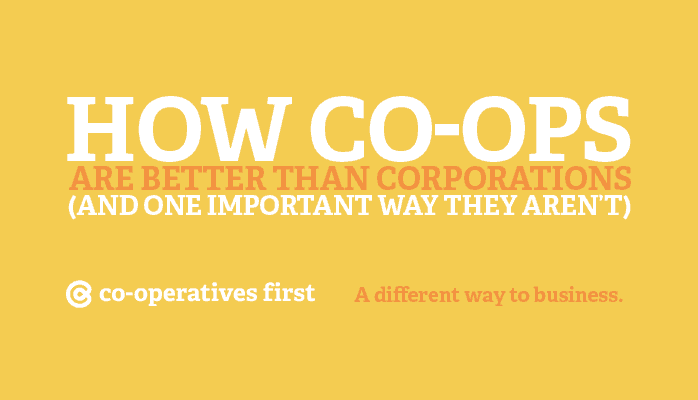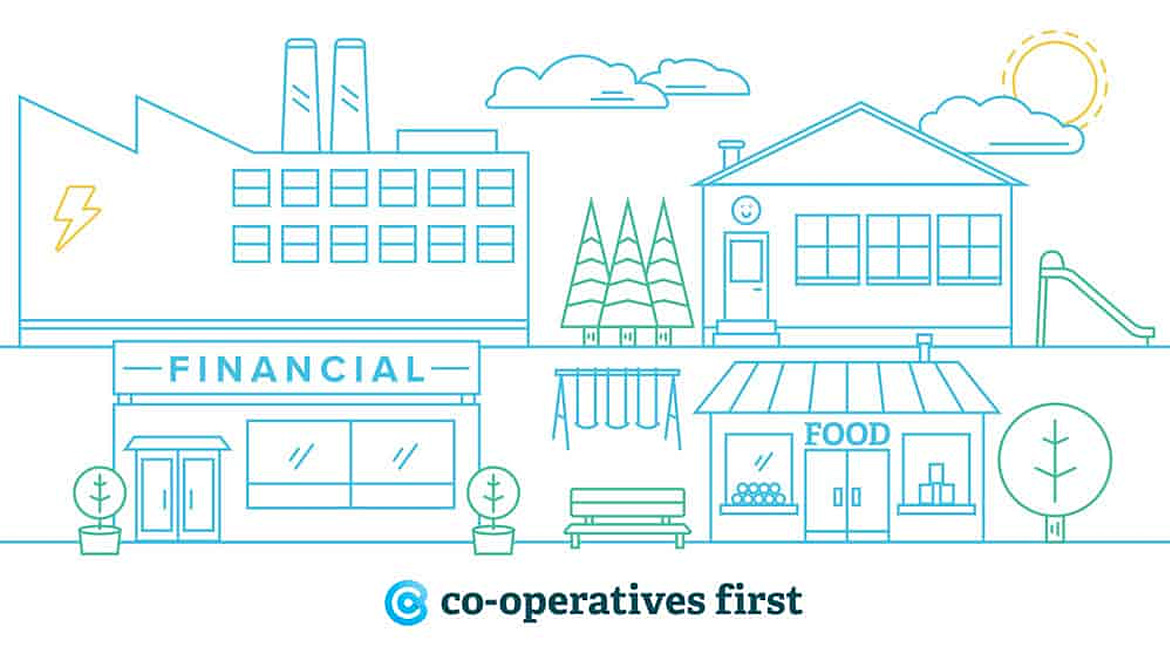Are co-ops are better than corporations? How are they worse?
At Co-operatives First, we sometimes get asked: “are co-ops better than corporations?”
Every business is different and reflects the concerns and interests of their shareholders. Plus, corporations come in a wide variety of shapes and sizes, from non-profits to global conglomerates. In fact, co-operatives are corporations, but with a specific structure that has a lot of applications.
This versatile structure can produce a co-op that looks a lot like a large, investor-driven corporation — or one that is very much like a small, charitable non-profit organization that provides community service.
That said, there are a few ways co-ops are better than “corporations” (i.e. large, investor-driven businesses). And one important way they aren’t.
Two Key Advantages
The co-operative business model has two key advantages. The first is how strongly it can support local economic, business and community development. The second is how versatile the model is – capturing both a small, three-person shop or a multi-billion dollar federation of stores, and just about everything in between.
But let’s have a closer look.
Profits stay local
While this may not apply to all co-operatives, many co-ops have a strong attachment to the communities where they do business. In these cases, the shareholders are often the same people using the business’ services or are local business-owners or producers using the co-op model to scale their individual businesses. In western Canada, these people have often been farmers.
Profits created by co-ops like these usually stay within the community through a few different ways.
Profits are:
1. Re-invested in the co-op (i.e. to expand services or undertake a new project in the community);
2. Distributed amongst shareholders (who live in the community);
3. Donated to local initiatives (sports teams, school programs, charities, etc. in the community); or
4. A combination of the above.
While there’s no reason shareholders of an investor-driven corporation can’t do the same – especially if they live in the community where they do business – in practice this is the exception rather than the rule. For many corporations that operate in communities separate from headquarters, profits will aggregate in the headquartering community and largely be dispersed to shareholders around the world.
For example, the Northwest Company is headquartered in Winnipeg, MB and owns a bunch of stores in the far north. With shareholders worldwide, profits made in northern communities will inevitably head south and from there be distributed to shareholders around the world.
With a local co-op, such as members of Arctic Co-operatives Limited (a competitor of the Northwest Company), more of the wealth coming into the community remains in the community through the ways we outline above, with a far smaller portion of wealth going south to suppliers.
For a small, remote community, every dollar that remains in the local economy has a major impact on the overall strength of the local economy and community well-being.
Decision-making is distributed
You’ll often hear co-operatives are defined by a “one member, one vote” system. For the most part, this is how co-ops structure shareholder voting rights. Co-ops with more than one class of shareholder might do it differently, but in general the “one member, one vote” rule applies.
One advantage of this is that it guards against hostile takeover or a single shareholder holding a majority of the decision-making power. In short, you can’t buy control of a co-operative company. This is one of the key differences between co-operatives and corporations.
Another advantage of distributed decision-making is longevity and stability, as co-ops tend to last longer than other types of businesses.
More responsive to the community
The best co-ops are strong because of a good governance structure and high level of member or shareholder engagement.
Solid member engagement and good governance not only increase member use of the co-op, but also ensure the co-op’s priorities match those of its shareholders through ongoing feedback channels. Stocksy United’s member chatroom, which is moderated by company executives, is a modern and effective innovation on this co-op practice.
Likewise, having local control of a business ensures that those who benefit from the business have a say over how it operates. This ensures that a co-op can respond to the concerns of its shareholders more effectively than most corporations.
Take the consumer co-op in Stanley Mission as an example. Rather than maximizing dividends to shareholders, the members wanted their business to invest in local sports teams and school breakfasts.
In comparison, the Northern Stores across northern Canada invest very little in the communities where they operate, and simply vacuum wealth out of northern communities with economies that often could benefit from every available nickel.
Tax benefits
Technically, co-ops face the same tax rates as corporations. But, there are a few key characteristics that provide some advantages to shareholders.
First, patronage dividends that members get from their retail co-ops are usually non-taxable, because they are earned by purchasing goods.
Second, co-operative businesses can distribute their dividends before paying corporate tax, avoiding double taxation. (This doesn’t save the shareholder from having to pay tax though.)
Third, some marketing and service co-operatives incorporate as non-profits to reduce the tax burden of their shareholders. Not the most flattering of examples, but KPMG probably uses this to their advantage.
One important disadvantage
There are many reasons people choose one business model over another. Size, scope, and efficiency are all common reasons why services are delivered through one mechanism and not another.
For the many instances where a co-operative structure makes a lot of sense, there is one major disadvantage of the co-operative model.
People are not familiar with the model
Despite being around for over five centuries, many people have a limited understanding of the benefits and versatility of the co-operative business model.
The reasons for this are many, but the impact is clear: fewer co-ops.
This is not the case for other corporate structures, and we have myriad examples of for-profit and non-profit corporations across Canada and around the world.
That’s why we’re here! To learn more about co-ops, what we do, and other cool stuff, sign up for our monthly newsletter.

 Written by
Written by 




